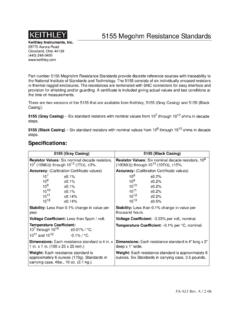Transcription of Y8100 DC/AC Current Probe - testequipment.center
1 INSTRUCTION manual Y8100 DC/AC Current Probe DESCRIPTION The Bell Y81GG DC/AC Current Probe is a clamp-on Probe that is used with a voltmeter, multi meter, or oscilloscope to read dc, ac, or composite (ac on dc) Current measurements. The jaws on the Y81GG are designed to clamp around conductors up to 3/4 inch in diameter. The pistol shape allows safe, easy, one hand operation when making Current measurements. APPLICATIONS i_ be used to measure any of the-iollowing: Ground currents ac and dc. Power supply ripple. Current distribution in multiple systems.
2 Current balance in two wires ac and dc. Current in audio distribution systems (using to Hz signals). Starting currents without introducing impedance (imparts negligible inductance in the mH range). Transformer currents. Battery currents. Current distribution and perform ripple Current tests in plating operations. Current transients (dc to 1 kHz) when used with an oscilloscope. FEATURES As shown in Figure 1-1, major features of the Y81 . include the following. Table 1-1 provides the specifications of the Y81 QQ. 1. Jaws - The jaws can enclose conductors up to 3/4 inch (19 mm) in diameter.
3 Except at the core closure, the jaws are insulated. The closure is chamfered for positive alignment and minimum air gap. The jaws are rated for voltages up to 6 QQV dc or 48QV ac. Inspect core closure area frequently for foreign material. Centering of conductors smaller than 3/4 inch in diameter is desireable, but not critical for specified accuracy. WARNING Do not use at voltages above 600V dc or 480V ac. Avoid snapping the jaws as this could damage the core. 2. Jaw Trigger - The jaw trigger is designed for easy, one-hand operation and positioned for maximum protection from circuit voltages.
4 3. Slide Lock - The slide lock mechanically locks the push-to read switch in the on or off position. 4. Push-To-Read-Switch - The push-to-read switch turr)s the Y81QQ on for zeroing and measurement. Switch operation also demagnetizes the core. 5. Output Banana Jacks - The output banana jacks are color coded red for positive and black for negative with reference to the Current direction arrow. They will accept standard dual o-rTridividuaT banana 6. Connection Cable - A 5-foot cable with standard dual banana connectors is supplied. A molded tab indicates the negative lead on the connectors.
5 7. Battery Compartment - The battery compartment can be reached by removing the butt plate, which is held in place by a single phillips screw. Contained in the battery compartment is the battery holder, which slides out to accept four "AA" alka line batteries (6 volts) -r ~uired for operation of the Y81 QQ. ,"OTE Support the battery holder when removing it to prevent unnec essary stress on the flexible leads connected to the unit. Cell polarity is molded into the battery holder and shouid be carefully observed when installing batteries. 8. Zero Adjustment Thumbwheel - Used to zero the voltage output from the Y81QQ on the meter before taking Current readings.
6 9. Battery-Low Indicator Light - Lights whenever battery voltage falls below that required for proper operation. Alkaline battery life under continuous operation is approximately hours. 1Q. Range Switch - The range switch is a two position slide switch for either 2QA or 2 GGA operation. 11. Current Direction Arrow - A positive (+) reading on dc indicates Current in the direction of the arrow. 12. Case - The case is made of high-impact, high-dielectric, precision-molded plastic. UNPACKING The Y8100 was packed and shipped in a container especially designed to protect your Current Probe .
7 Check your shipment thoroughly. If anything is wrong, contact the place of purchase immediately or Bell. If return is necessary, please use the original shipping container. If the original container is not avail able, a new one can be obtained from Bell. Please give the instrument model number when requesting a new container. BATTERY INSTALLATION To install new batteries, remove the battery cover (butt plate) by unscrewing the single phillips screw. Carefully remove the plas tic battery holder being sure not to pull too hard and loosen or disconnect the two flexible leads to the unit.
8 The battery holder has cell polarity indicator marks (+) (-) to ensure proper installa tion of the four new batteries. Install the batteries as indicated on the battery holder and carefully insert the encased batteries back in the handle. Install the battery cover (butt plate). There are four "AA" alkaline batteries that supply +6V operating power for the Y8100 . (See Figure 4-1). A "batteries low" indica tor light, located just above the "zero adjustment thumbwheel," will come on whenever the batteries require replacement. CAUTION If the Y8100 is not to be used for an extended period, it is recommended that the batteries be removed to protect the unit.
9 OPERATING instructions INTRODUCTION The following measurement techniques are provided as guidelines to be followed when using the Y8100 . Included are procedures for measuring ac, dc, composite (ac on dc) currents, safety hints, and measurement notes. These procedures should be read carefully before using the Y81 00. SAFETY HINTS 1. Remove batteries when not using the Current Probe for an extended period of time. 2. Do not clamp the Probe onto anything other than the conduc tor being measured. The Probe may hang from aperture if necessary to read the remote meter.
10 3. Observe all maximum circuit voltage warnings. 4. The aperture is insulated except at core closure. Withstand voltage from core to output terminals and case is safe for the working voltage specified. Avoid touching uninsulated core closure area to conductor. MEASUREMENT NOTES 1. There can be a few millivolts of thermal drift during the first 60 to 120 seconds of warmup of the Current Probe . For maximum dc accuracy, a warmup of 60 seconds before zeroing will eliminate 90-95% of the drift. Figure 1-1 OUTPUT BANANA JACKS BATIERY COMPARTMENT / NEGATIVE TAB 2. The Earth's magnetic field is an influence to be zeroed out before taking dc readings.












